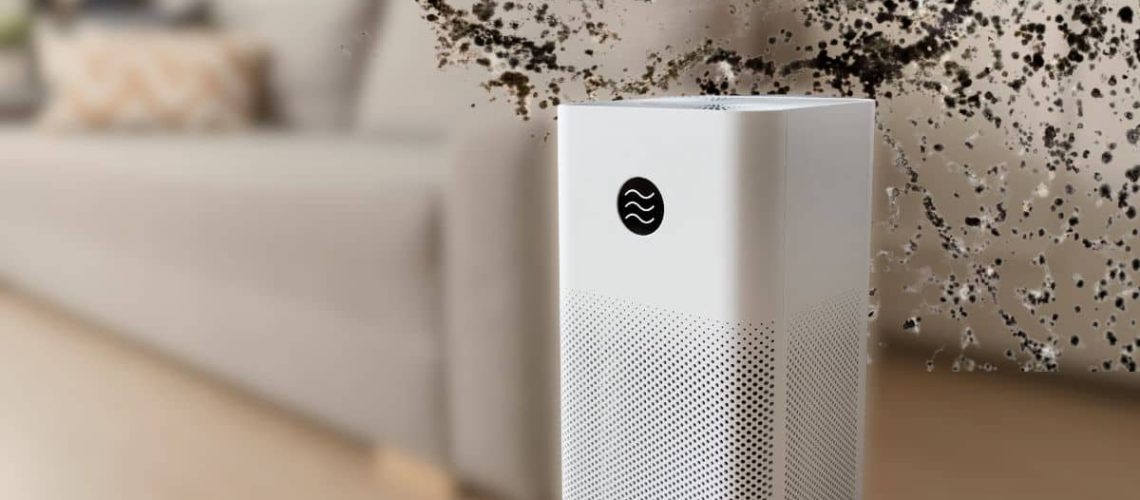This guide from Inspection Gator explains how an air purifier interacts with mold, what they can and can’t help with, and how air quality testing fits into keeping your home healthy and mold-free.
Mold can be sneaky. You might smell a musty odor, see small dark patches on a wall or vent, or notice your allergies getting worse indoors. For homeowners in Northeast Texas, Southwest Arkansas, and Southeast Oklahoma, these are common signs that mold may be affecting indoor air quality.
Air purifiers often seem like a quick fix for fresher, cleaner air. But how much do they really help with mold? And when is professional testing the better move?
Table of Contents
ToggleHow Mold Forms and Spreads Indoors
Mold is a type of fungus that reproduces through microscopic spores.
These spores are always present in the air but stay inactive until they find a damp environment. Once they land on moisture-rich materials like wood, carpet, or drywall, they begin to grow and spread.
The EPA notes that mold can start forming within 24 to 48 hours when surfaces remain damp. In humid regions, even normal household activities such as showering or cooking can raise indoor humidity to levels where mold flourishes.
Mold often appears in:
- Bathrooms and kitchens with limited ventilation
- Attics and crawl spaces that trap heat and moisture
- Window sills, baseboards, and wall corners where condensation collects
- HVAC ducts or filters that remain damp after cooling cycles
Homes with poor airflow or clogged filters can trap spores, letting them circulate continuously through the HVAC system. The more humidity builds up indoors, the easier it is for mold to find new surfaces to colonize.
What Can You Expect From Your Air Purifier?
An air purifier will help clean the air by pulling it through filters that capture airborne particles such as dust, pollen, and mold spores. They can noticeably improve indoor comfort and odor, but their impact depends on the type of purifier and how it’s used.

What Air Purifiers Can Do
- Capture floating mold spores before they land and grow
- Lessen musty odors linked to mold metabolism
- Improve respiratory comfort by reducing allergens in circulation
What They Can’t Do
- Eliminate mold colonies already growing on walls, furniture, or insulation
- Fix leaks, poor ventilation, or excess humidity
- Replace inspection or moisture diagnostics
Air purifiers help limit airborne exposure, but should never be treated as a permanent mold solution. They are most effective when paired with proper home maintenance and professional inspection.
Best Air Purifiers for Mold Control
Not all air purifiers work the same. The most reliable models focus on particle capture and odor control.
1. HEPA Filtration Systems
High-Efficiency Particulate Air (HEPA) filters trap up to 99.97% of particles as small as 0.3 microns, which includes most airborne mold spores. Look for multi-stage systems that also include pre-filters for larger debris and activated carbon layers for odor removal.
2. Activated Carbon Filters
Activated carbon filters absorb gases and volatile organic compounds (VOCs) produced by mold and other contaminants. They don’t stop mold growth, but they make indoor air feel noticeably cleaner.
3. UV-C Light Purifiers
Some purifiers use ultraviolet light to destroy or deactivate spores as they pass through. The CDC confirms that UV-C light can neutralize certain airborne organisms, but effectiveness depends on exposure time and maintenance of the bulb.
4. Whole-House Air Purifiers
Installed within your HVAC system, these models clean air as it circulates throughout your home. They work well when paired with consistent filter changes and professional HVAC service.
Why Mold Keeps Returning
If you’ve scrubbed visible mold only for it to come back, the root cause is likely still active moisture. Mold thrives where water, condensation, or humidity lingers.
Common hidden moisture sources include:
- Leaks from plumbing or HVAC lines
- Foundation cracks are letting groundwater seep in
- Roof leaks during seasonal storms
- Damp insulation or unvented attics
- High indoor humidity from poor airflow
The Mayo Clinic notes that even dead mold spores can continue to trigger allergy symptoms.
This means that while cleaning or filtration can make a space smell better, spores often remain embedded in drywall or behind trim until the underlying moisture is resolved.
Inspection Gator’s certified mold inspections are designed to identify exactly where moisture originates. Using moisture meters, thermal imaging, and air sampling, they can determine whether you have an isolated issue or a larger structural concern.
When to Schedule Air Quality Testing
Air purifiers make your home smell cleaner, but they can’t confirm whether mold levels are safe. Professional air quality testing measures the concentration of mold spores and other particulates in your indoor environment.
You should schedule air quality testing when:
- You notice persistent musty odors with no visible mold
- Family members develop unexplained sinus or breathing problems indoors
- The property recently experienced leaks or flooding
- You’ve moved into a previously vacant or foreclosed home
- You want confirmation after remediation or renovation
The testing process involves collecting indoor and outdoor samples, which are then compared in a laboratory to see if spore levels are elevated. Results provide a scientific basis for whether further inspection or repairs are needed.
For homeowners in humid regions, testing every few years or after significant weather events offers reassurance that the air in your home remains healthy.
The Role of Mold Inspection
Before investing in new filters or air purifiers, it’s important to know whether mold is active and where it’s hiding.
A mold inspection identifies visible and hidden growth, measures humidity, and pinpoints how spores might be spreading.
During a typical inspection, trained professionals will:
- Assess moisture-prone areas such as attics, basements, or crawl spaces
- Use thermal imaging to detect damp insulation or structural leaks
- Collect air and surface samples for lab testing
- Provide a detailed report outlining findings and recommendations
Combining mold inspection with air quality testing gives homeowners a full picture of their home’s indoor health. It’s the most reliable way to know whether air purification will be helpful or merely temporary.

Combining Air Purifiers With Prevention Strategies
Air purifiers perform best when paired with consistent prevention habits. Mold control depends on addressing the conditions that allow it to grow in the first place.
1. Keep Humidity in Check
Use dehumidifiers or run your air conditioner regularly to maintain humidity between 30% and 50%, the range recommended by the EPA. Consider using a digital hygrometer to monitor indoor levels throughout the year.
2. Improve Ventilation
Install exhaust fans in bathrooms, kitchens, and laundry areas. Proper airflow helps moisture evaporate instead of settling into building materials.
3. Seal and Repair Leaks Quickly
Inspect plumbing lines, roof flashing, and window seals. Even small leaks can introduce enough moisture to start mold growth within days.
4. Maintain HVAC Systems
Change air filters monthly and schedule seasonal tune-ups. Clean coils, ducts, and drip pans reduce condensation buildup that could spread spores through the system.
5. Schedule Regular Inspections
Schedule mold or moisture inspections to help prevent large-scale problems. Even if your home looks clean, testing ensures you catch invisible moisture before it escalates.
By combining these steps, homeowners can keep air purifiers working at peak efficiency and drastically reduce mold-related risks indoors.
Signs It’s Time to Call for Professional Help
Air purifiers can mask early signs of mold, so it’s important to stay alert for physical and environmental clues.
Contact a professional if you notice:
- Persistent musty or earthy smells
- Peeling paint, dark stains, or bubbling drywall
- Visible mold on ceilings, window sills, or air vents
- Worsening allergy symptoms that improve when you leave home
- Unexplained humidity or dampness in specific rooms
Even if the visible area seems small, these are often indicators of deeper moisture trapped behind walls or floors. A professional mold inspection and air test can confirm whether hidden issues exist.
Other Related Questions
Can an air purifier help prevent mold from growing in the first place?
It can reduce airborne spores, but it cannot regulate humidity. Related topics like dehumidifier placement, crawl space ventilation, and seasonal home maintenance show how moisture control is the foundation of prevention.
Should I test for mold if I already use a purifier?
Yes. Air testing verifies that your purifier is working effectively and ensures you aren’t overlooking hidden contamination. This connects naturally to Inspection Gator’s mold inspection and air quality testing services.
Are older homes more likely to have mold?
Yes. Homes built decades ago may have less insulation, worn roofing, or outdated ventilation. Related inspection topics, such as roof integrity and attic airflow, tie into identifying these issues.
Can air purifiers help after remediation or cleanup?
They can. Once visible mold is professionally removed, an air purifier helps capture any remaining airborne spores and maintain cleaner air long-term. Related blogs on post-inspection testing and long-term home maintenance support this discussion.
When to Call a Professional
If you suspect mold, smell something musty, or experience persistent humidity problems, professional inspection and testing are the most reliable next steps.
Inspection Gator serves Northeast Texas, Southwest Arkansas, and Southeast Oklahoma, helping homeowners uncover hidden mold and improve indoor air quality.
The certified team provides thorough mold inspections, air sampling, and lab analysis to reveal what’s really happening inside your home.
Conclusion
An air purifier can support a cleaner, fresher indoor environment and help reduce mold spore levels in the air. However, they cannot replace professional testing or moisture control. The key to long-term results lies in combining air purification with humidity management, regular inspections, and routine maintenance.
By understanding both what air purifiers can do and what they can’t, homeowners can make smart, proactive choices for healthier air.
Inspection Gator provides the professional insight and testing needed to pinpoint mold sources, verify air quality, and help protect your home from future growth.





